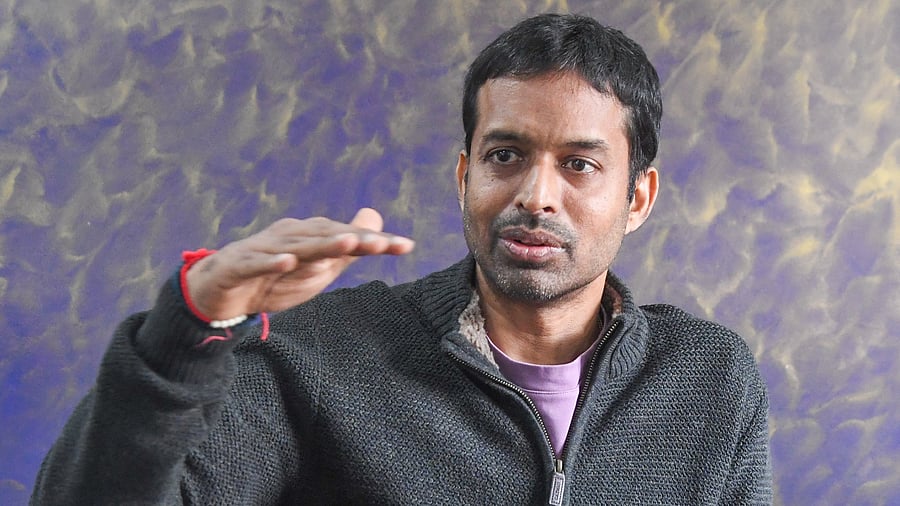
Pullela Gopichand insists that you must put the best players together in one place to ensure the quality of badminton improves overall.
Credit: DH PHOTO/ SK Dinesh
Bengaluru: Gopi and his ways’ were initially questioned and then frowned upon. His need to be a strict disciplinarian to his trainees was a hot topic of debate when Pullela Gopichand the player decided to become Pullela Gopichand the coach two decades ago.
It took a while, but once his recipe for success changed the landscape of Indian badminton, ‘Gopi and his ways’ would go on to be admired and appreciated.
And even after producing an incredible list of players which includes Saina Nehwal, PV Sindhu, Kidambi Srikanth, HS Prannoy, Parupalli Kashyap among many others, the former All-England champion and Dronacharya Awardee feels compelled to ask people to take badminton seriously.
Gopichand, India’s chief national coach, was at the Karnataka Badminton Association on Sunday for the 86th Senior National Badminton Championships and spoke about the importance of the event, on developing the ecosystem rather than dwelling on talent, and how playing professional badminton is as tough or tougher than rocket science.
Here are few of the questions her answered:
Could you talk about a player-coach relationship in India?
A player-coach relationship is very different from education. For example, a teacher teaches you till primary school, then hands you over to high school. The high school teacher hands you over to a graduate school then a PhD or a doctorate school, masters... So there are four, five transfers which actually happen. But here (in badminton) you are looking at a grassroots coach wanting to take them to the highest level because their growth lies in the player’s growth.
An ideal scenario would be where the player is actually transferred to the next level and the coach benefits from it. So we need to change this fundamental defect in the ecosystem where grassroots to intermediate to elite to a national team needs to be a transfer which happens very well, where the grassroots coach or the intermediate coach is respected even more.
What is the right kind of guidance?
It is very individualistic in some sense but also very systemic in some sense. Because if I were to talk from a country’s perspective, I would say collective practice is primary. If you put the best players together in one place, there are more chances that each one spars with the other, each one competes with the other and the general level of the country goes up. If you look at doubles, mixed doubles, I think you need numbers. You cannot work in silos of one size.
Your thoughts about the current crop of singles players?
My concern is not the talent. My concern is what have you done in the last 10 years? Could we convert the best talent we had? It is a complex ecosystem. High performance needs you to be in control of selection, calendar, players, support staff, coaches. That’s too much control to have in a major sport like badminton.
So when there was nobody watching Saina and Sindhu, it was easier for me to do it (take control). With Srikanth and Prannoy too and then Satwik(sairaj Rankireddy). But as time goes by, there are too many mindsets and ecosystems.
Either you go back and say ‘you decide for the country’ and that’s what China does very well. There’s one big boss who’s deciding for the country and what he says happens down the street. Nobody is talking. Either we do that or we evolve a system where at least everybody is on the same page. High performance is a 24x7, 365-day job. You have to do it. If you don’t, you won’t be getting results.
How complicated is badminton really?
Everybody thinks somehow that this is not rocket science and it’s very easy. If a person can learn software and rocket science, taking up badminton is considered to be easy. That’s the mindset which people have. And unfortunately, that’s the mindset which administrators, politicians, bureaucrats also have, that this is not (as tough as) rocket science. The reality is this is far bigger (different). And that understanding is very critical. Now, you cannot explain this to many people. It’s very difficult for them to understand. But if I don’t say it, who else will?
On the event coming back to Bengaluru
It’s really nice and KBA has been a place I have very good memories of and they organise the tournament really well. It’s good to see so many young players participating. There’s great energy in there and some very good talent.
A tournament you have won 5 times has no top players competing..
It’s going to be challenging, because you finish the two (World Tour) Finals like four days ago. It’s always going to be a challenge when you want athletes to play two circuits, international and national, or national and state.